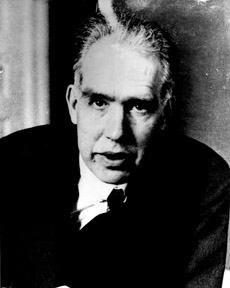Bohrium facts for kids

Bohrium is a special chemical element that scientists have created. You can find it on the periodic table of elements at position number 107. It's named after a famous scientist named Niels Bohr.
Long ago, a scientist named Dmitri Mendeleev thought this element might exist. He called it eka-rhenium because it was predicted to be near Rhenium on the Periodic Table. Bohrium acts a lot like rhenium in its chemical behavior.
Contents
Bohrium's Different Forms (Isotopes)
Bohrium doesn't exist naturally on Earth. It also doesn't have any stable forms. Scientists have made several different versions of bohrium in their labs. These different versions are called isotopes. They make them by smashing two atoms together or by watching heavier elements break down.
Scientists have found twelve different isotopes of bohrium. Their atomic masses range from 260 to 278. One of these, bohrium-262, has a special "metastable state." Almost all these isotopes break down by giving off tiny particles called alpha particles. Some other bohrium isotopes might break down by splitting apart, which is called spontaneous fission.
Lighter isotopes of bohrium usually don't last very long. For example, bohrium-260, 261, and 262 last for less than a tenth of a second. Other isotopes like bohrium-264, 265, 266, and 271 are a bit more stable, lasting for about one second. Bohrium-267 and 272 can last for about ten seconds.
The heaviest isotopes are the most stable ones. Bohrium-270 and 274 can last for a few minutes. There's also an unconfirmed isotope, bohrium-278, which might last for about 11.5 minutes. This would make it one of the longest-lasting superheavy elements ever found!
Scientists create these isotopes in different ways. Some are made by "cold fusion," where atoms are fused at lower energies. Others are found when heavier elements like meitnerium and roentgenium decay. The heavier, neutron-rich isotopes are made by hitting special targets, like actinide elements, with other particles.
What Scientists Think Bohrium is Like
It's really hard to study bohrium. This is because we can only make very small amounts of it. Also, it breaks down super fast. So, scientists mostly have to guess what its properties are. They use what they know about other elements in the same group on the periodic table.
How Bohrium Acts Chemically
Bohrium is the fifth element in a group of metals called "transition metals." It's also the heaviest element in group 7 of the periodic table. This group includes manganese, technetium, and rhenium. Elements in this group often have a special chemical state called +7. Scientists think bohrium will also have a stable +7 state.
Bohrium might also have lower states, like +4 or +3. The +7 state is probably found in compounds like "perbohrate," which is similar to "permanganate" or "perrhenate." However, bohrium(VII) might not be stable in water. It would likely change quickly to a more stable bohrium(IV) state.
Lighter elements in group 7 form compounds called "heptoxides." These are gases at normal temperatures. So, bohrium should also form a gas called Bh2O7. This gas should dissolve in water to make "perbohric acid."
Elements like rhenium and technetium also form compounds called "oxychlorides." These are made by adding chlorine to their oxides. So, bohrium should form BhO3Cl. Scientists have found that these oxychlorides become less gassy as you go down the group. This means BhO3Cl should be less gassy than TcO3Cl or ReO3Cl. This idea was actually tested and confirmed!
What Bohrium Looks Like and Its Atoms
Scientists expect bohrium to be a solid at room temperature. They think it will have a crystal structure similar to rhenium. Early guesses for its density were very high, but newer calculations suggest it's around 26–27 grams per cubic centimeter.
The size of a bohrium atom is thought to be about 128 picometers. When bohrium loses an electron to become an ion (Bh+), it's predicted to lose a different type of electron than its lighter relatives. This is due to special effects that happen in very heavy elements.
Studying Bohrium in the Lab
In 1995, scientists tried to study bohrium but didn't succeed. This led to new studies on how to best investigate bohrium. They compared it to technetium and rhenium and worked on how to remove other unwanted elements.
In 2000, scientists finally confirmed that bohrium acts like a typical group 7 element. A team at the Paul Scherrer Institute (PSI) did an experiment using six atoms of bohrium-267. They made these atoms by reacting berkelium with neon ions.
The bohrium atoms were then mixed with a special gas to form a compound called a volatile oxychloride. This compound was similar to rhenium oxychloride. The experiment also made similar compounds from technetium and rhenium. By studying how these compounds stuck to surfaces, scientists confirmed that bohrium forms a volatile oxychloride. This showed that bohrium truly belongs in group 7.
The experiment also measured how strongly these oxychlorides stuck to surfaces. The results matched what scientists had predicted. This showed that bohrium oxychloride is less gassy than technetium or rhenium oxychlorides.
Here's a simplified idea of the chemical reaction:
- 2 Bh + 3 O2 + 2 HCl → 2 BhO3Cl + H2
Scientists hope to do more experiments with bohrium. The heavier isotopes of bohrium last longer, which makes them easier to study. Even though some heavy isotopes are hard to make, others can be created more easily by watching heavier elements like moscovium and nihonium decay.
Images for kids
-
Element 107 was originally proposed to be named after Niels Bohr, a Danish nuclear physicist, with the name nielsbohrium (Ns). This name was later changed by IUPAC to bohrium (Bh).
See also
 In Spanish: Bohrio para niños
In Spanish: Bohrio para niños


